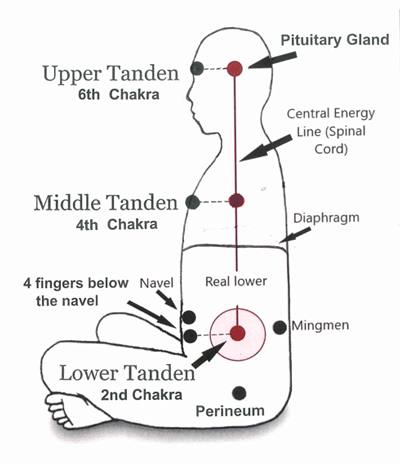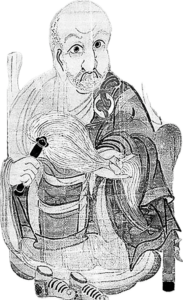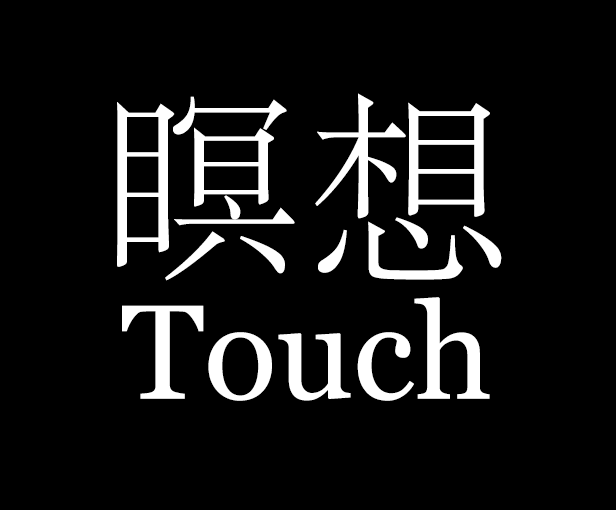
Tanden Breath & Longevity
Ancient Eastern Health Perspectives & Healing Wisdom

TANDEN: THE VITAL CENTER
“Tanden” is an acupoint that is located 3 or 4 fingers down from the navel and 3 or 4 fingers inwards in the Hara*. The second chakra, tanden, is said to be a vitally important “place for me”. Young children naturally breathe from this point which is a reason for their abundant joy. They intuitively take deeper, full breaths — one may observe the big rise and fall of a child’s belly with each breath. In addition, the diaphragm that controls breathing can be trained. You can boost your blood circulation (internal heat) and immunity to improve your body’s metabolism, and eliminate all kinds of disorders.
Many people who are not feeling well are cold here.
*Hara (the entire abdomen) has psychological and spiritual connotations in Japanese language and culture. In fact, hara can be seen as the unification of a person’s physical, psychological and spiritual dimensions.

Hakuin Zenji
Buddha, who was born in the ancient Indian era, learned the breathing method “Anapana Sachi” during a practice of penance. It is said that Buddha was born from training to hold his breath. This breathing method was spread by the Zen monk, Hakuin Zenji, during the Edo period in Japan.
It is said that Hakuin Zenji had a pulmonary tuberculosis disease, and was able to overcome it through a secret healing method, taught by Hakuyu Sennin, a medicine man. The secret method, the “Internal Introspective Observation Method”, focuses on tanden (lower abdomen) and breath.
This breathing practice is known as “tanden breathing” or “zen breathing”.
Our breath follows the mental, emotional and physical energy of attention. How we breathe with our Prana/Qi/Ki in life, is reflected through our bodily posture and internal functions. Eighty percent of brain activity depends on the internal activity of our abdomen/hara.
If breathing consciousness is not engaged during healing practices, then the practice remains at a superficial level, stuck in old habits. Our breath reflects mind, heart, body and spirit. Restorative tanden breath can collaborate with touch meditation to remove habitual patterns. Through this practice, it is possible to regain an organic flow of seasonal Qi. We can embody nature’s grace, growth, expansion, and renewal.
When we are born the first thing we respond/do is inhale (cry out), for energetic and physical engagement with the body.
When we die, the last thing we do is exhale (or cough), for spiritual departure from the body.
Our breath is much more than a respiratory system to exchange oxygen and carbon dioxide.
Spiritual worlds and physical worlds are interwoven through the bridge of each breath. We can watch our involuntary pausing between the in breath and out breath. Deep inhales are life affirming. Long holding of the breath can lead us into a state of non-living. Life and death reside next to each other through each breath, Experienced in a moment of silence at classical music concert, or being under the water like an embryo in a mother’s womb, or being in the eye of a storm. Mindful breathing can give us an opportunity to review and renew our life in each moment. All it takes is present awareness.
“Silence is the garden of meditation “
Inhalation is a receptive state of inspiration, providing vital oxygen with fresh Qi to our bloodstream and stimulating the sympathetic nervous system.
When we inhale mindlessly, our blood tends to shift to more acidic and blood pressure can rise. When we are agitated, our breath tends to get stuck along the inhalation, like a fish out of water.
Exhalation expires or releases acidic, toxic Qi with carbon dioxide. When we exhale mindfully, our blood tends to shift to alkaline and blood pressure can drop and stimulate the parasympathetic nervous system.
When we laugh, our breath becomes a series of out breaths and the whole body relaxes like a young child. Babies are masters of this, giggly without reason.
Deepening (long sustained) exhalation is the key for creating more respiratory and abdominal space, allowing for a more organic intake of oxygen to support our life source as mitochondria. We can intuitively experience spiritual life through mindful breathing, eventually leading to the realization that we are one, a part of the vast universe. We are human beings instead of human doings. Mindful breathing leads to a state of natural wellbeing, or shizentai.
Imagine the infinite exchanges of breath between ourselves and others, an unconscious network of endless giving and receiving.
Mindful breathing creates a web of love and space, uniting human beings globally.
Right now we are breathing with the entire universe. Each breath connects us with worlds beyond time and space. Inhale as the universe exhales, exhale as universe inhales. Circular, healing breath. We are inhaling a thousand million molecules that were exhaled by our ancestors. It is possible that we breathe in molecules that passed through enlightened spiritual teachers, including Buddha.
Self breathing assessment by Touch
Close your eyes then place your left palm over tanden, and your right palm over your heart. Observe how your breath naturally moves through the touch and acknowledge where you hold your tension. After some self breathing assessment, you are ready for Tanden breathing. You are welcome to explore Tanden breathing in the MeisoTouch video library.
After you have engaged with your whole abdominal awareness through Tanden breathing meditation, soon Serotonin will be released from your brain.
Serotonin (known as a happy hormone) is essential for our mental health and parasympathetic nervous system.
Now you can smile and relax into the present moment.
Additional benefits of Zen/ Tanden breathing meditation
Oxytocin is a hormone that acts on organs through Vagus nerve in the body (including the breast and uterus) and as a chemical messenger in the brain. Oxytocin controls key aspects of the reproductive system, including childbirth and lactation. Also referred to as a “love hormone”, levels of oxytocin are increased by hugging and orgasm. Oxytocin is also associated with empathy, trust and relationship-building, and can stabalize moods. It is released by the posterior pituitary gland.
Endorphins are sometimes called “natural pain killers,” since they alleviate pain in the body. Your body releases endorphins when confronted with pain or stress. Endorphins are also released during pleasurable activities such as meditation, exercise, bodywork, eating and sex. Endorphins help relieve pain, reduce stress and improve your sense of well-being.
Dopamine is most notably involved in helping us feel pleasure as part of the brain’s reward system. Meditation, sex, shopping, smelling cookies baking in the oven — all these things can trigger a dopamine release, or a “dopamine rush.” This feel-good neurotransmitter is also involved in reinforcement.
In addition, neurotransmitters such as serotonin and dopamine working in the brain – also known as “happiness substances”, are synthesized to improve Hara and the intestinal microbiome.
